We fervently hope that you greatly enjoy and appreciate this article about these 7 Spectacular Indonesian Species that we present to you herein. It was certainly our great pleasure to compile it for you, our readers. We hope you find it intriguing and edifying.
It’s also our fervent hope that reading this article serves to whet your appetite to learn of more such natural wonders. Most regions of the world boast many wonderful species, to be certain. This region, however, seems to hold more than its fair share, in some ways.
Gray’s Leaf Insect
Gray’s Leaf Insect Facts
- Leading off this article about these 7 Spectacular Indonesian Species is the intriguingly-evolved creature known by the name of the Gray’s Leaf Insect.
- This intriguing product of natural evolution most frequently goes by the somewhat informative common name for very good reasons. It also has another, less often used common name, though. That’s the equally informative term of the Java Leaf Insect.
- Professional entomologists, though, typically refer to the species by its formal scientific name. That, however, is the tongue-twisting term of Pulchriphyllium bioculatum. Regardless of the term used to refer to it, the insect remains a fascinating one.
- The first formal recognition of the arthropod as a separate and distinct species, furthermore, occurred in the year 1832. This took place as a result of the work of George Robert Gray, the highly respected English zoologist, and part of the British Museum.
- This particular small but nonetheless impressive animal also represented a personal milestone for the eminent researcher. That’s because the creature also represented the first phasmid he discovered. He later went on to discover many more, however.
- For the moment, the IUCN has no listing for the Gray’s Leaf Insect on its Red List of Threatened Species. That’s due to the fact that, for the moment, at least, it appears to be maintaining a population base that’s both sizeable and sufficient within its range.
- The amazing insect must nevertheless be considered to be facing at least some threats to its continued existence. Given the nature and location of its range, habitat loss poses a potential danger. Its greatest threat, however, likely consists of climate change.
Gray’s Leaf Insect Physical Description
It’s worth noting that, while the Gray’s Leaf Insect does impress those who encounter it, the creature does not do so due to sheer size. That’s due to the fact that it also ranks as a moderately-sized member of its Order. It’s nonetheless a respectable specimen.
Like many insects, it also displays a moderate degree of the physiological characteristic of sexual dimorphism. In its specific case, though, this trait mainfests itself in terms of simple physical size. Specifically, females attain a shorter length, though, thicker body.
More precisely, males attain an average overall length of roughly 2.6 – 3.7 in (6.6 – 9.4 cm). The shorter females, though, only grow to an average length of 1.8 – 2.7 in (4.6 – 6.9 cm). Females of the species also develop an abdomen that remains narrower at the base.
Both genders, however, manifest the same general color pattern. Both the body and the legs display a primarily green background, though shades vary. Random markings consisting of such hues as orange and yellow also manifest, varying between individuals of either gender.
Females of the Gray’s Leaf Insect further distinguish themselves from their male counterparts in yet another manner. Males typically possess significantly longer antennae than the females. Males, furthermore, have fully functioning wings, while females do not.
- Kingdom: Animalia
- Phylum: Arthropoda
- Class: Insecta
- Order: Phasmatodea
- Family: Phylliidae
- Genus: Pulchriphyllium
- Species: P. bioculatum
Gray’s Leaf Insect Distribution, Habitat, and Ecology
Fortunately, both for the Gray’s Leaf Insect, and those of us who appreciate Nature, the marvelous insect appears to inhabit a relatively large swathe of the globe. That’s due to the fact that its known habitat range covers a quite respectable portion of southeastern Asia.
It does, however, also appear in several other regions of the world. These consist of the Seychelles, Mauritius, and Madagascar. In its main area, though, it seems widespread throughout such countries as India, Sri Lanka, China, Borneo, Java, and Malaysia.
In whatever region one encounters it, though, it displays a strong preference in terms of its choice of habitat. The vast majority of individuals live in tropical regions. There, the arthropod mostly makes its home in sections of the locally abundant tropical rainforests.
It evolved as highly dependant on specific environmental conditions. These include warmer temperatures, between 75 – 82 F24 – 28 C). The species further requires moderately high humdity levels, not surprisingly, given the region in which the insect evolved.
Like most of its relatives, the Gray’s Leaf Insect further evolved as a strict herbivore. Wherever it lives, it adapts to the locally prevalent vegetation. It does, however, display certain strong preferences in its diet. These include such foods as guava and mango.
During breeding season, the females lays approximately 100 eggs. She lays these, however, over a period of several days. She also lays eggs with or without fertilization, in a process called parthenogenesis. Those laid without fertilization invariably produce females.
Limnonectes larvaepartus
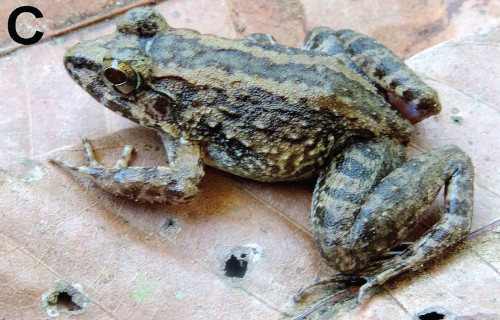
CCL: https://bit.ly/3zWPZdf
Limnonectes larvaepartus Facts
- Next up among our choices for inclusion in this compilation of 7 Spectacular Indonesian Species comes the remarkable amphibian known as the Limnonectes larvaepartus.
- The recently discovered species known by the extremely hard to pronounce name truly represents a highly unique species of frog. This newly recognized and quite remarkable animal species does not yet possess a common name, unfortunately.
- The amazing creature received its first scientific recognition in 1994, though under a different, temporary designation. Its first formal description and naming took place in 2014, however. That occurred at the hands of a group of three herpetologists.
- Astonishingly, this incredible amphibian also represents one of only four known varieties of a frog to develop fang-like teeth. Currently 6,455 known extant species of frog exist. This animal now represents one of only twelve to reproduce internally.
- To add to its distinctiveness, it is the only known frog on earth to not only conceive internally, but to give birth to fully developed tadpoles. All of the other species of frogs known to science that also give birth to live young deliver froglets.
- The IUCN now lists the Limnonectes larvaepartus as Least Concern on its Red List of Threatened Species. That status may soon change, though, since its numbers seem to be diminishing. It faces many threats, including that of climate change.

Limnonectes larvaepartus Physical Description
Though the Limnonectes larvaepartus fascinates researchers, it does not do so based on size. That’s because the amphibian remains a somewhat diminutive species. Overall, mature adults of this variety of frog attain an average length of roughly 1.5 in (3.8 cm).
This small marvel of Nature further exhibits a slight degree of the physiological characteristic of sexual dimorphism. In its particular case, this trait manifests itself in the fact that females average slightly greater in length than their male counterparts.
Not to be completely overshadowed, though, the shorter males typically possess a stouter body shape. The otherwise impressive Limnonectes larvaepartus nevertheless also remains an overall lightweight, with mature adults averaging only 0.18 oz (5 grams) in weight.
Its appearance, meanwhile, tends to vary between individuals. The upper portions of the body vary in color the most. This portion may be either brownish gray, golden tan or reddish-brown. Its underbelly, though, develops as either cream-colored or yellowish.
- Kingdom: Animalia
- Phylum: Chordata
- Class: Amphibia
- Order: Anura
- Family: Dicroglossidae
- Genus: Limnonectes
- Species: L. larvaepartus

CCL: https://bit.ly/3zWPZdf
Limnonectes larvaepartus Distribution, Habitat, and Ecology
The diminutive Limnonectes larvaepartus regrettably remains endemic to a highly restricted region of the globe. That small area consists of only the island of Sulawesi. That’s in Indonesia, in Asia. It’s also unclear if the creature ever possessed a more extensive range.
It further demonstrates very specific preferences in terms of where it chooses to make its home. The nature of that habitat, unfortunately, makes detailed study of the animal difficult. The living area of the diminutive marvel consists of a very dense jungle.
Even there, however, the Limnonectes larvaepartus only appears in a very specific type of local environment. To the knowledge of scientists, the isolated animal only makes its home near streams, and only in the more mountainous regions of its island home.
The precise dietary habits of this wonder of evolution has not yet been fully determined, due to the inherent difficulties of studying it in detail. Like its many relatives, though, adults feed on the various small insects species so prevalent within its zone of habitation.
After mating, females typically produce about 100 eggs. How the surprising creature achieves internal reproduction actually remains a complete mystery to researchers, however. This occurs because the male possesses no discernible reproductive organ.
Saltwater Crocodile
Saltwater Crocodile Facts
- The third entry into this listing of 7 Spectacular Indonesian Species is the powerful predator known simply, but appropriately, as the Saltwater Crocodile.
- This magnificent work of Nature and evolution most frequently goes by its informative common name for excellent reasons. That term, however accurate, isn’t the only name applied to it, however. In point of fact, several others are sometimes used.
- The alternate names themselves also often provide clues to its nature. These include such terms as the Indo-Pacific crocodile, esturarine crocodile, sea crocodile, and marine crocodile. The animal’s also sometimes informally referred to as the saltie.
- Professional researchers, meanwhile, typically refer to the creature by its scientific name. That’s the technical name of Crocodylus porosus. Regardless of which name one chooses to use when referring to it, though, it’s an especially impressive crocodilian.
- The renowned German naturalist Johann Gottlob Theanenus Schneider made the first formal recognition of the reptile. The well known researcher acknowledged this incredible example of evolution as a separate and distinct species in the year 1801.
- The animal appears, for the moment, at least, to be maintiaing a population base that’s both stable and sufficient. That further seems to hold true throughout the entirety of its range. The IUCN therefore, presently lists the reptile as Least Concern on its Red List.
- The amazing Saltwater Crocodile nevertheless faces dangers that could potentially threaten it in the future. Habitat loss poses a potential threat, due to human expansion. The ongoing process of climate change, however, likely condstitutes its greatest threat.
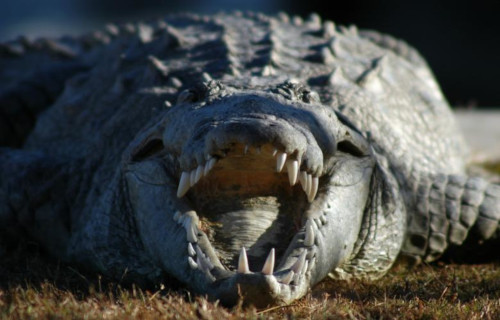
Saltwater Crocodile Physical Description
Sheer size alone isn’t the only trait of the Saltwater Crocodile that impresses those who view the creature. That characteristic nonetheless certainly does bear mentioning. That’s because this species presently constitutes the largest of all currently known crocodilians.
The species also, like many of its relatives, displays a degree of the physiological characteristic of sexual dimorphism. In its specific case, though, this ranks as particularly severe. That’s due to the fact that the males attain a length roughly twice that of females.
The significantly longer males reach an average legnth measuring about 20 ft (6 m). Exceptional specimens, however, sometimes attain lengths of as much as 23 ft (7 m). The males further reach a weight that averages approximately 1,000 lbs (453.6 kg).
Females of the species, meanwhile, only attain an average length measuring approximately 10 ft (3 m). Even the exceptional individuals rarely exceed this by much. Sheer mass, however, remains starkly contrasted, with females rarely exceeding 330 lb (150 kg)!
While rare indivuals exceed these weights in both genders, the two sexes remain otherwise virtually indistinguishable in simple appearance. Its snout also develops wider than most related species. A pair of ridges also extends the length of the snout, from the eyes.
The body of the Saltwater Crocodile further differs from most others in its girth. Its body develops as much stouter in form. In coloring, most adults manifest a dark, greenish-drab shade. A few light gray or tan areas sometimes appear, however, in various spots.
- Kingdom: Animalia
- Phylum: Chordata
- Class: Reptilia
- Order: Crocodilia
- Family: Crocodylidae
- Genus: Crocodylus
- Species: C. porosus
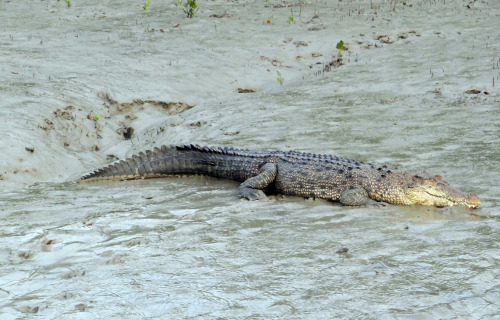
Saltwater Crocodile Distribution, Habitat, and Ecology
Fortunately, the remarkable Saltwater Crocodile evolved as native to a comparatively broad swathe of the globe. Interestingly, furthermore, that range roughly straddles the equator. It further does so, by random chance, almost equally across both hemispheres.
This animal appears as far north as the eastern coast of the country of India. From there, its range extends through Sri Lanka, Bangladesh, Myanmar, Thailand, Malaysia, Cambodia, and Vietnam, to name a few. That range extends as far south as northern Australia.
Wherever it makes an appearance, though, it displays highly specific preferences in terms of habitat. That’s because the remarkable crocodilian makes its home solely along the coastline. Individuals do, however, occasionally swim far out to sea, outside their range.
Most specimens spend the vast majority of their time inhabiting very specific habitat types. These principally consist of river deltas and mangrove swamps. In some regions, the incredible animal also migrate to warmer parts of its range during the local winter season.
The Saltwater Crocodile also differs from most of its kin in yet another manner. Although most crocodilains live as social creatures, this species mainly lives a solitary life. Most individuals, especially the males, further exhibit extremely strong territorial drives.
It also spends much of its time in a lethargic state. This allows it to survive for months at a time without feeding. When it does feed, however, it does so strictly as a carnivore, like other crocodiles. It further represents an apex predator throughout most areas of its range.
Malaysian Dead Leaf Mantis
Malaysian Dead Leaf Mantis Facts
- Appearing next among our choices for inclusion in this article about 7 Spectacular Indonesian Species comes the highly efficient hunter known as the Malaysian Dead Leaf Mantis.
- That’s the most frequently used common name for this marvel of Nature and evolution, and for very good reasons. But it’s not the only one used for it. That’s because it’s also sometimes referred to by the somewhat misleading term of the giant dead leaf mantis.
- Professional researchers, though, typically refer to it by its formal scientific name. That term, however, like many such technical names, remains somewhat hard to pronounce. That’s because professionals refer to the insect by the term Deroplatys desiccata.
- Regardless of what one chooses to call it, it’s a fascinating and captivating creature. The alternate common name, though, is slightly misleading. That, however, isn’t at all unusual, as common names frequently give a false impression of the species.
- Though larger than some of its kind, it’s by no means a giant among its roughly 1,800 known related species, overall. It does qualify as a giant, in a way, though. That’s because it attains a somewhat larger size than any other leaf mantis, specifically.
- The highly respected English entomologist, as well as archaeologist, John Obadiah Westwood, made the first recorded recognition of it as a separate and distinct species. This scientifically noteworthy achievement he accomplished in the year 1839.
- Fortunately, its population base appears to be both sizeable and stable. This situation further appears to hold true throughout the entirety of its native range. Unfortunately, it’s also become quite popular among those who keep insects in captivity.
Malaysian Dead Leaf Mantis Physical Description
Like virtually all of its many relatives, the magnificent Malaysian Dead Leaf Mantis ranks as a master of camouflage. In its specific case, its own name gives an indication its approach. That’s due to the fact that, when it wishes, it closely resembles a dead, dry leaf.
Like many insects of all kinds, it also displays the physiological characteristic of sexual dimorphism. In its case, this trait manifests itself in terms of sheer physical size. The overall size difference between the two genders, however, remains comparatively minor.
More precisely, the females, again, like many of its relatives, attains a greater length than the male of the species. Mature females reach an average length of 3 – 3.1 in (7.5 – 8 cm). Males, meanwhile, grow to a body length that averages roughly 2.6 – 2.8 in (6.5 – 7 cm).
Otherwise, the two sexes displays virtually identical patterns of coloring, with only slight variations among individuals. Those patterns, though, include a very respectable range of colors. These run from nearly black, to shades of brown, to an orange-brown hue.
The highly extended thorax possesses an extremely flattened shape. It also manifests intricate patterns, like the veins on a leaf, on the upper surface of its wings. The underside, however, has a mainly black background, with a large eye-like spot on each wing.
- Kingdom: Animalia
- Phylum: Arthropoda
- Class: Insecta
- Order: Mantodea
- Family: Deroplatyidae
- Genus: Deroplatys
- Species: D. dessicata
Malaysian Dead Leaf Mantis Distribution, Habitat, and Ecology
The mesmerizing Malysian Dead Leaf Mantis inhabits a moderately expansive part of the world. This range consists of the region generally known as southeast Asia. More specifically, it’s known to live in Sumatra, the Philippines, Borneo, Indonesia, and Malaysia.
Within that range, though, it fortunately seems to be moderately adapable in terms of its habitat requirements. That’s due to the fact that specimens appear in regions of both tropical forest and scrubland. For now, no evidence that it ever lived elsewhere exists.
It’s also supremely adapted for the environment in which it lives. Its coloring, as well as its body shape and design, provides it with excellent natural camouflage. The insect even appears to sway in the breeze, mimicking the movements of a dried up leaf.
This learned behavioral pattern serves the amazing arthropod well in its typical habitat range, offering it a certain measure of protection from its own predators. Those include the usual species, such as tree climbing lizards, snakes, and birds, among others.
Like its numerous relatives, the Malaysian Dead Leaf Mantis evolved as a carnivore. Also like them, it’s a master hunter, preferring to hunt as an ambush predator. It feeds opportunistically, consuming virtually any prey of sufficient size, most especially moths.
Mycena Chlorophos
Mycena Chlorophos Facts
- Taking the fifth spot in this compendium of 7 Spectacular Indonesian Species, though only due to random selection, is the amazing Mycena Chlorophos.
- This truly extraordinary variety of fungus remains known to researchers by its relatively unassuming scientific name. There’s a good reason for that, however. That’s because, for the moment, the remarkable species has no generally accepted common name.
- Only the name of the awesome fungus fails to impress those who encounter it or learn of it, however. Nothing else about it fails to do so. This fungi actually represents one of the handful of known related species that actually displays a natural luminescence.
- The first recorded scientific description of the Mycena Chlorophos actually occurred all the way back in the year 1860. This occurred as a result of the combined efforts of the English researcher Miles Berkeley, and the American botanist, Moses Ashley Curtis.
- Quite unfortunately, however, scientists still do not know a significant amount about this incredible work of Nature. This regrettable lack of knowledge principally occurs due to a combination of it short duration and highly limited territorial range.
- Currently, the IUCN has no listing for it on its Red List of Threatened Species. The marvel does, however, face several serious threats to its existence. Although habitat loss remains a danger, its greatest peril most likely stems from climate change.
Mycena Chlorophos Physical Description
Regardless of its other claim to fame, the Mycena Chlorophos represents a comparatively small variety of mushroom. Thankfully, though, Nature often demonstrates that physical size as absolutely no bearing on the impressiveness of its many distinctive creations.
The height of its comparatively thin stalk actually varies quite significantly, measuring from 0.2 – 1.2 in (6 – 30 mm). Its cap, meanwhile, also ranges in size over a broad range. But, this portion of it typically does not exceed roughly 1.2 in (30 mm) in total diameter.
The same cap also possesses a thin coating of a harmless, though surprisingly sticky, substance. The most notable feature of the Mycena Chlorophos, however, obviously remains its naturally occurring luminescence. This presents as a pale green.
It also holds one more fascinating, if somewhat unpleasant, characteristic. This unique wonder of evolution emits a comparatively strong odor of ammonia. Due to the presence of this particular scent, the relative edibility of this fungi remains in question
- Kingdom: Fungi
- Phylum: Basidiomycota
- Class: Agaricomycetes
- Order: Agaricales
- Family: Mycenaceae
- Genus: Mycena
- Species: M. chlorophos
Mycena Chlorophos Distribution, Habitat and Ecology
The Mycena Chlorophos grows endemically only in a very limited area of the world. This consists of certain portions of subtropical Asia. More precisely, these sections include the countries of Taiwan, Polynesia, Japan, Sri Lanka, and the island of Java in Indonesia.
To the amazement of some, this mushroom also grows in completely different parts of the globe. In fact, these alternate zones include small portions of Brazil and Australia. However, experts believe that humans accidentally transported it to those locations.
Most fortunately for it, the Mycena Chlorophos has another trait working in its favor. Within these widely different ranges, the species appears to have evolved as highly adaptable. As a result of this evolutionary advantage, it may be found in a variety of forest habitats.
Wherever it appears, though, it nonetheless displays a decided preference for a specific environment. That’s due to the fact that it appears almost exclusively among areas of woody debris. This most commonly includes pieces of fallen bark, branches, and twigs.
The trademark bioluminescence for which it remains best known, however, doesn’t last very long. In point of fact, it’s most pronounced when the mushroom first develops. Afterward, the eerie glow slowly fades over a period that typically measures roughly 72 hours.
Wallace’s Flying Frog
Wallace’s Flying Frog Facts
- Next up in this compendium of 7 Spectacular Indonesian Species is a truly amazing creature known by the common name of the Wallace’s Flying Frog.
- The very name of this marvel of Nature serves to indicate just how extraordinary it is. The common term derives partly from its unique ability, and also from the name of the individual that first discovered it. That was British biologist, Alfred R. Wallace.
- The generally used named for this minuscule marvel of Nature remains much easier to remember than its scientific name, however. That tongue-twisting term, typically only used by professionals, is that of Rhacophorus nigropalmatus.
- Not surprisingly, the name’s somewhat misleading, since the animal does not actually fly. It does, however, glide short distances from tree to tree. Though not, again to one’s astonishment, the only known frog to possess this ability, it’s among the largest.
- The exact extent of the population of the Wallace’s Flying Frog continues to elude researchers. This occurs due to the fact that sightings happen infrequently. Experts further remain undecided as to whether this indicates a small population or not.
- For the moment, pending more information, the IUCN lists the remarkable and distinctive creature as Least Concern. This status, while subject to revision, presently appears on the organization’s routinely published Red List of Threatened Species.
- The fascinating animal nonetheless faces several clear threats to its continued existence. Ongoing habitat loss now represents an imminent danger to it. Its greatest peril, however, now comes in the form of the effects of escalating climate change.
Wallace’s Flying Frog Physical Description
The impressiveness of the aptly-named Wallace’s Flying Frog does not originate solely with its aerial abilities. Its size and appearance both also serve to merit interest in the wonder. In fact, it constitutes a slightly larger than average variety of frog.
The amazing amphibian further displays the physiological characteristic of sexual dimorphism, like many of its kin. In its specific case, this trait manifests itself in the fact that females, averaging 3.9 in (10 cm) in length, attain a slightly greater size than males.
Most people generally consider the Wallace’s Flying Frog to be highly photogenic, and rightfully so. The colors the animal presents typically include a bright green on the back. It also, however, usually displays either yellow or a pale white on the underside.
It also evolved over-sized webbed feet that it utilizes to glide from tree to tree. The eyes, meanwhile, grow quite large, and possess striking horizontal pupils. Not stopping there, the species also has large toe pads, which help it cling to trees as it lands from its flight.
- Kingdom: Animalia
- Phylum: Chordata
- Class: Amphibia
- Order: Anura
- Family: Rhacophoridae
- Genus: Rhacophorus
- Species: R. nigropalmatus
Wallace’s Flying Frog Distribution, Habitat, and Ecology
The remarkable Wallace’s Flying Frog, in fact, actually inhabits a moderately broad section of the world, at least when compared to related species. That habitat range, as it currently stands known, extends from the Malay Peninsula to western Indonesia, in Asia.
Within that somewhat extensive zone of habitation, though, it displays quite specific preferences for where it appears. To the knowledge of researchers, it only inhabits regions of rainforest, for starters. Even there, though, it specifically limits its range.
The amphibian does not seem to reside at altitudes of greater than 1,970 ft (600 m) above sea level. Yet another habitat requirement remains the local presence of either small pools of fresh water or slow-moving streams. These it requires for its evolved breeding habits.
The Wallace’s Flying Frog spends the majority of its life in the trees, descending only to mate and lay eggs. Its known diet, meanwhile, consists entirely of a variety of small insects. Finally, its only known natural predators seem to be various arboreal snakes.
Emerald Swallowtail
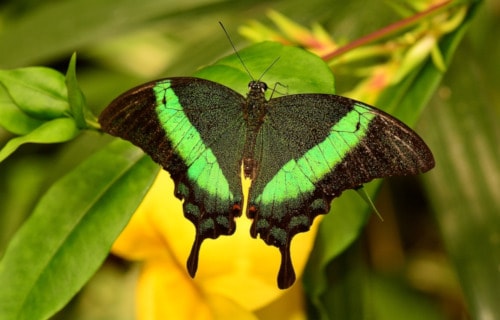
Emerald Swallowtail Facts
- Closing out this article about 7 Spectacular Indonesain Species we present the small but magnificent Lepidoptera known as the Emerald Swallowtail.
- This dazzling natural marvel bears several common names, the most frequently used being the one we are employing. The other terms often applied to it, though, include those of the emerald peacock and the deceptive term of green-banded peacock.
- Its official scientific name, however, remains much more difficult to pronounce. That because professionals use the term Papilio palinurus to formally refer to it. By either of these names, however, it easily ranks as one of the most beautiful of Lepidoptera.
- A total of 6 recognized subspecies also exist of this insect. Perhaps somewhat miraculously, for the moment, each of these subspecies, as well as the Emerald Swallowtail, appears on the IUCN Red List of Threatened Species, as Least Concern.
- That fact owes its existence to several factors. The first of these is the fact that it evolved as native to a relatively large area. The second reason may be less laudable, but nonetheless does play a role in protecting and helping to insure its continued survival.
- That’s because this marvelous butterfly consistently ranks as one of the most popular in butterfly houses around the world. Though certainly pleasing, the fortunate fact of its relative safety from extinction could easily change in the near future, however.
- Within its native habitat range, the marvelous work of Nature faces several threats. The actions of collectors remains one of these, of course. Its greatest peril, though, no doubt consists of the ongoing and ever-increasing effects of climate change.
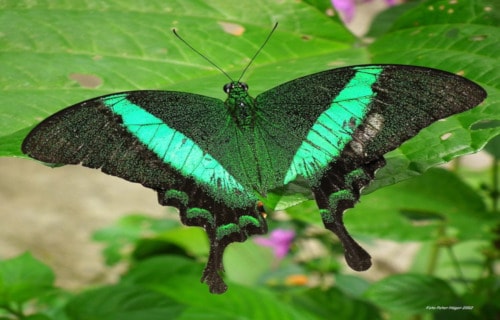
Emerald Swallowtail Physical Description
The magnificent Emerald Swallowtail impresses those who see it many ways. Unlike some beautiful Lepidoptera, however, it does so not only with its visual splendor, but in terms of sheer size, as well. In point of fact, it’s a larger than average variety of butterfly.
Also distinguishing itself from many other butterflies, this breathtaking beauty does not display any noticeable sexual dimorphism. Distinguishing males from females, therefore, can be quite difficult for the untrained observer. Both sexes are gorgeous, though.
Individuals of both genders attain an average wingspan of between 3.1 – 3.9 in (8 – 10 cm). Astonishingly, though, the top and bottom of the two wings display radically different patterns. While that’s not uncommon, this species takes the principle to a high level.
The top side serves as the origin of the various common names, including that of Emerald Swallowtail. That’s due to the amazing green color displayed. This ranges from dark green, to a shade that’s almost black. It also shows dark green bands in a V shape.
The underside, meanwhile, shows a completely different pattern. This primarily consists of shades of back. Numerous blue, white, and orange spots further appear here. These typically manifest themselves along the edges of the hindwings of the insect, though.
Astonishingly, these colors do not form due to natural pigments, as in the vast majority on insects. These in fact appear due to the presence of countless tiny naturally occurring prisms. Light refracting through these creates the magnificent colors perceived.
- Kingdom: Animalia
- Phylum: Arthropoda
- Class: Insecta
- Order: Lepidoptera
- Family: Papilionidae
- Genus: Papilio
- Species: P. palinurus
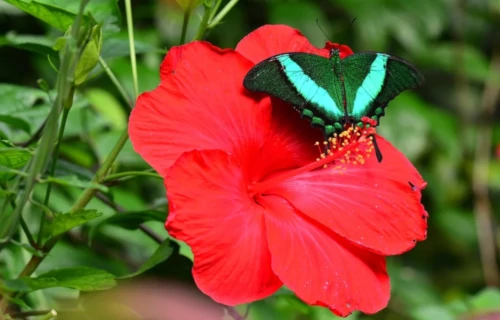
Emerald Swallowtail Distribution, Habitat, and Ecology
The Emerald Swallowtail has a comparatively wide range. This is fortunate for both it and those who appreciate its beauty. That’s due to the fact that the incredible arthropod evolved as native to a broad portion of what now constitutes the continent of Asia.
More specifically, though, it appears naturally in a range that extends from the Philippines to southern portions of India. The wonderful insect even, for the moment, at least, holds small yet stable populations on some of the islands included in that impressive range.
Like most species, it also has specific preferences for its choice of habitat. It nonetheless proves itself adaptable when the need presents itself. In Nature, the creature generally lives in various open areas. These principally include forest clearings and along river banks.
It does, however, also often appear in and around empty lots, city parks, and even human habitations. In each of these habitats, it nevertheless displays specific dietary patterns. The caterpillar form feeds almost exclusively on plants in the citrus and rue families.
The adults, meanwhile, solely feed on nectar. This typically, though not exclusively, comes from the same plants as the younger form. The Emerald Swallowtail also serves as an important pollinator for many local species. Males even establish firm territorial boundaries.
7 Spectacular Indonesian Species
We sincerely hope that you have thoroughly enjoyed reading, and hopefull learning from, this article about 7 Spectacular Indonesian Species. It’s also our fervent hope that doing so has left you with either a new or renewed appreciation for such wonders.
Sadly, however, many of the wonders of this region of the globe, as well as throughout the entirety of the world, now find themselves in dire peril. It’s up to each and every one of us to do al that we can to protect and preserve the many various marvels of Nature.
Check out our other articles on 5 Island-Evolved Herbaceous Plants, The Mighty Tornado, 6 Marine Apex Predators, Earth’s 7 Rarest Butterflies, 7 Highly Unusual Lakes
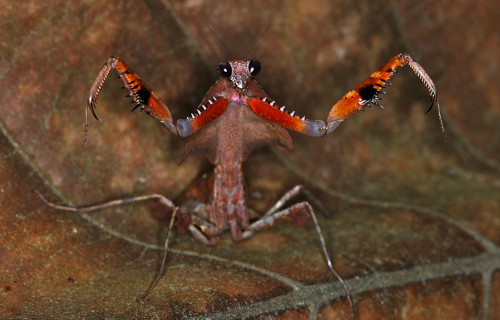
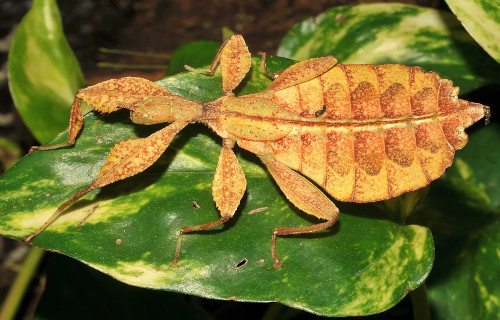
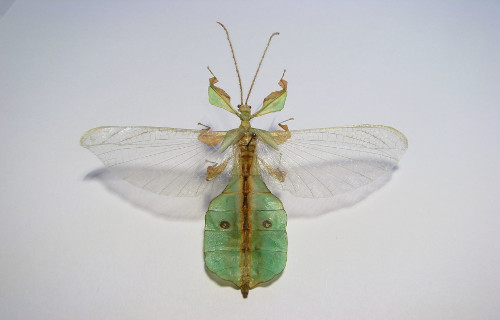
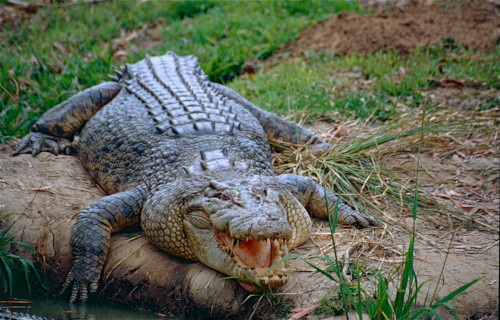
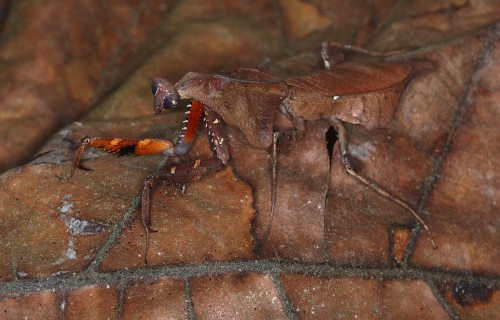
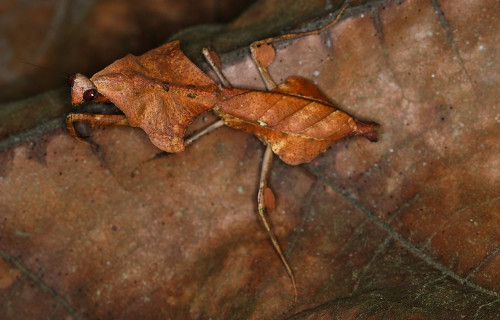
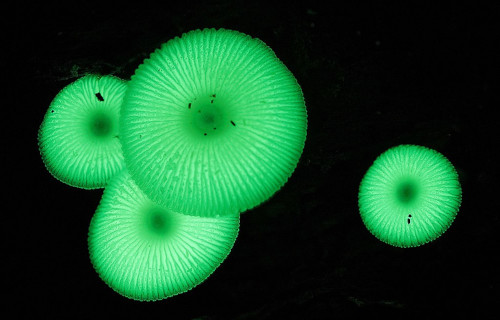
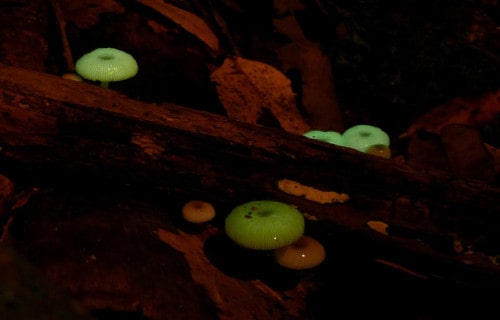
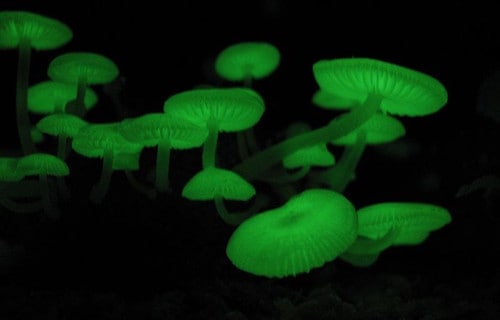
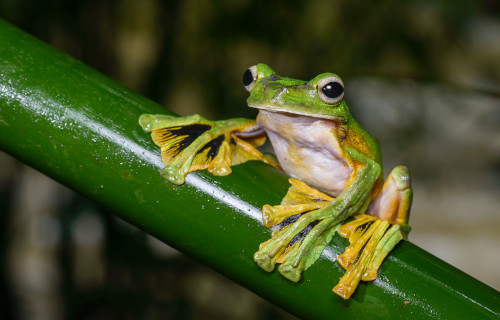
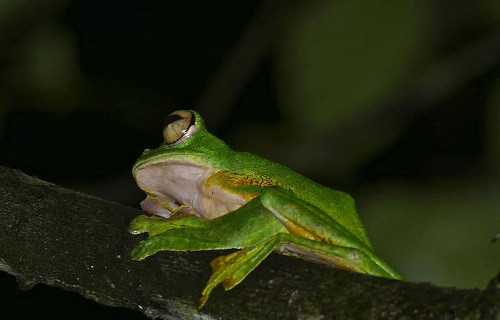
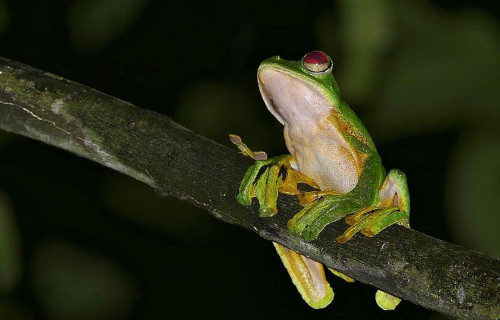









Leave a Reply